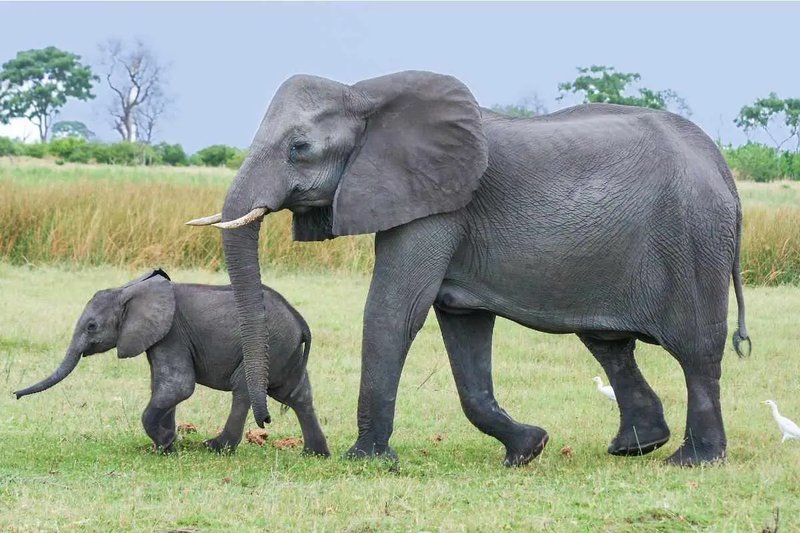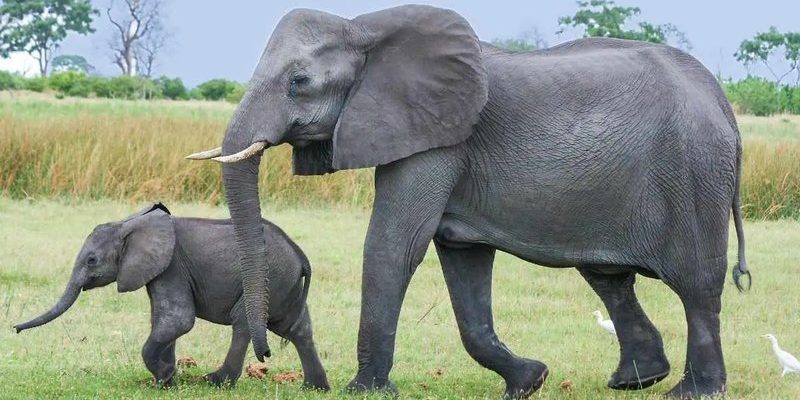
Picture it like this: you’re at a gathering where everyone has their unique style—some wear hats, others wear glasses—but you can definitely spot the family resemblance. Just like humans, these animals have features that might remind you of the African Bush Elephant, yet they have their own stories to tell. Let me take you on a journey to meet ten of these animals and help you learn how to recognize them, even if they might look a bit like elephants at first glance.
1. Indian Elephant
The Indian Elephant is one of the most recognizable relatives of the African Bush Elephant. While it shares the same family, it’s smaller, weighing around 5,500 to 11,000 pounds, compared to the African counterpart’s hefty 12,000 pounds or more. One of the most striking differences is in the ears; Indian elephants have smaller, rounded ears that resemble a fan, whereas African elephants sport large, floppy ears shaped like the African continent.
Their behavior also differs. Indian elephants tend to be more temperamental, often found in dense forest areas rather than open savannas. They are also known to have a more varied diet, munching on grasses, fruits, and even tree bark. When observing them, a careful eye will catch the subtle differences in their postures and interactions, making it easier to tell these gentle giants apart.
2. Asian Elephant
Often confused with the Indian elephant, the Asian Elephant is another close relative. Although similar in size and appearance, Asian elephants typically have smaller, straighter backs. One fascinating aspect is their tusks; only male Asian elephants can have prominent tusks, while most females don’t.
In terms of habitat, Asian elephants are often found in India, Sri Lanka, and Southeast Asia. Their diet also leans heavily on vegetation found in rainforests and grasslands. This sets them apart from their African cousins, who thrive in more open environments. When comparing them side by side, the shape of the head and the different ear sizes can help you distinguish them easily.
3. African Forest Elephant
Now, let’s head back to Africa but into the dense jungles—here you’ll find the African Forest Elephant. Smaller and lighter than its bush counterpart, the forest elephant weighs between 5,000 to 10,000 pounds. One of the most notable differences is their straight tusks—which are thinner and more delicate—compared to the massive, curved tusks of the African Bush Elephant.
Their habitat is another giveaway. While the bush elephant roams the savanna, the forest elephant prefers dense forests. They also spend a lot of time foraging for fruits and leaves. If you ever spot a herd in the wild, observe their smaller stature and quieter demeanor; they are generally more elusive and shyer than the more boisterous bush elephants.
4. Hippopotamus
This one might surprise you! While hippos are not closely related to elephants, their large size and semi-aquatic lifestyle can draw comparisons. Hippos can weigh up to 8,000 pounds and have a wide, barrel physique that could remind you of an elephant’s bulk, especially when they’re submerged in water.
The key difference here lies in their appearance and behavior. Hippos have a large, rounded head with big mouths but no trunk. They spend much of their time in water, surfacing mainly for grazing at night. If you see a giant creature lounging in a riverbank, chances are it’s a hippo, not an elephant!
5. Manatee
Manatees, often called “sea cows,” are gentle giants of the waters and bear resemblance to elephants in their slow-moving, peaceful nature. Weighing between 800 to 1,200 pounds, manatees have a round, bulky body and paddle-like flippers.
The major difference is that manatees are fully aquatic, living in warm waters and munching on underwater vegetation. They lack the large ears and trunk of elephants and instead have a more streamlined shape adapted for life underwater. Their gentle demeanor is what connects them to elephants, as both animals exhibit a calm, serene presence in their habitats.
6. Rhinoceros
The rhinoceros, or rhino for short, is another large land mammal that might remind you of elephants due to their size and tough skin. Rhinos, depending on the species, can weigh anywhere from 1,800 to 5,000 pounds. The most notable feature is their large horn or horns protruding from their snouts.
Though they share a similar habitat with African elephants, rhinos have a more solid build and shorter legs. They also lack the social structure of elephants; rhinos are generally solitary creatures, whereas elephants are highly social animals. Remembering these distinctions in behavior and physical traits can help you tell them apart easily.
7. Giraffe
Although not as closely related, the giraffe stands out in the animal kingdom with its long neck and legs. Adult giraffes can reach heights of up to 18 feet and weigh around 2,600 pounds. When seen from a distance, the combination of size and shape can give a passing resemblance to elephants.
However, the differences are clear when you look closer. Giraffes have a distinctive coat pattern and long necks designed for browsing tall trees. Their diet consists mainly of leaves and twigs, while elephants graze on grass and bark. So while they might both be giants of the savanna, their habits and appearances set them apart distinctly.
8. Cape Buffalo
The Cape Buffalo, known for its robust build and large, curved horns, is another animal found in Africa that can remind us of elephants. They can weigh up to 2,000 pounds and are often seen in herds, much like elephants.
However, their smaller stature and different horn structure make them easily distinguishable. Buffalos are grazers, often seen in open grasslands, whereas elephants are browsers. Their social dynamics differ greatly, as buffalo herds can be quite aggressive, while elephants are more nurturing and protective of their young.
9. Walrus
The walrus, with its massive size and tusks, brings a unique spin to this comparison. Walruses can weigh up to 2,000 pounds and have a blubbery body covered in whiskers. They live in cold waters of the Arctic and have a somewhat similar lazy demeanor as elephants resting under a tree.
When observing a walrus, however, you’ll notice prominent tusks and a lack of legs. They also spend a lot of time on ice or in water, contrasting with the terrestrial lifestyle of elephants. The rounder shape and aquatic adaptations help set them apart, even if they share a similar hefty presence.
10. Woolly Mammoth (Extinct)
Let’s take a trip back in time to the woolly mammoth—an extinct relative of the modern elephant. These furry giants roamed the Earth during the Ice Age, and while they were covered in long hair, they had similar features to the African Bush Elephant, such as large tusks and a trunk.
While we won’t see any living woolly mammoths today, their resemblance to elephants helps us understand their family tree. The main difference was their thick fur, adapted for cold climates, unlike the African elephants which thrive in warm weather. Recognizing these connections gives us a peek into the fascinating history of elephants and their relatives.
In summary, while the African Bush Elephant is a truly unique creature, it shares traits with a variety of other animals. Understanding these similarities and distinctions can deepen your appreciation for wildlife. Next time you’re on a safari or visiting a zoo, you’ll have a richer context to identify these wonderful creatures. Happy exploring!

